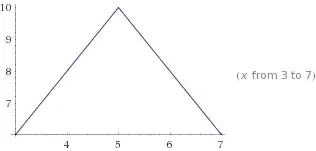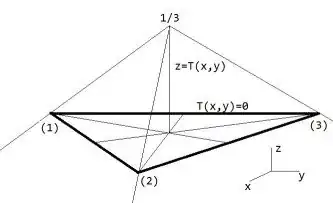Okay, so I have an answer.
It's a very cheeky answer, which relies on a lot of technicalities, but to make a long story short, we're going to glue together a bunch of functions into a three-sided shape.
Before we get into what that's going to look like, I think you should see the glue. It relies on a few properties of zero. Namely:
- No two positive real nonzero numbers can be added to produce zero.
- Zero multiplied by any value results in zero.
- No two nonzero real numbers can be multiplied together to produce zero.
This gives us a pair of formulas which can in turn be evaluated almost like Boolean logic statements:
$$ a*b = 0$$
This bakes a logical OR into our formula; you'll only get zero as the result if $a$ is zero or $b$ is zero. If both of them are real numbers with nonzero values, the result you get will also be nonzero.
$$ |a|+|b| = 0$$
This bakes in a logical AND; you'll only get zero as the result if $a$ and $b$ are both zero. Note the use of absolute values; this ensures that $a$ and $b$ both have to be evaluated as positive numbers, and this formula wouldn't work without them, since it's entirely possible to have $a = -b$.
Finally, take note of the fact that standard formulas are either defined in terms of zero or are easily re-framed into terms of zero, which gives us some nice plug-and-play capabilities.
Overall, our formula will basically be this:
$$AB*AC*BC=0$$
Or, in plain speak: "The point $(x,y)$ is a solution for triangle $ABC$ if it's a solution for line segment $AB$, line segment $AC$, or line segment $BC$."
The problem is, we don't have a standard equation for a line segment. We could conceivably make one if we pointed two rays at each other (such that all colinear points between their two points of origin are encompassed in a solution set), but we don't have a standard equation for rays either.
What we do have is some black magic:
$$ my (|x-2x_0|+x)/2 - mx (y + y_0 - x_0) = 0$$
$$ mx (|y-2y_0|+x)/2 - my (x + x_0 - y_0) = 0$$
Each of these equations produces a solution set which encompasses both a ray, originating from the point $(x_0, y_0)$ and travelling in the direction $(mx, my)$, and a second ray originating from the same point and travelling parallel to one of the axes (x-axis for the first formula, y-axis for the second). If you AND these two formulas together, you'll therefore get a ray. However, if you AND them together coming from opposite directions, you'll get a line segment instead, which means that while we could point two rays at each other by defining them individually, we can halve the size of our final formula by defining the line segments directly.
So then, for each segment, we get the following formulas:
$$ AB : |((y_b - y_a) (|x-2x_a|+x)/2 - (x_b - x_a)(y + y_a - x_a))|+|((x_a - x_b) (|y-2y_b|+x)/2 - (y_a - y_b)(x + x_b - y_b))| = 0$$
$$ AC : |((y_c - y_a) (|x-2x_a|+x)/2 - (x_c - x_a)(y + y_a - x_a))|+|((x_a - x_c) (|y-2y_c|+x)/2 - (y_a - y_c)(x + x_c - y_c))| = 0$$
$$ BC : |((y_b - y_c) (|x-2x_c|+x)/2 - (x_b - x_a)(y + y_c - x_c))|+|((x_c - x_b) (|y-2y_b|+x)/2 - (y_c - y_b)(x + x_b - y_b))| = 0$$
Which gives us our final longform equation of (*inhales*):
$$ (|((y_b - y_a) (|x-2x_a|+x)/2 - (x_b - x_a)(y + y_a - x_a))|+|((x_a - x_b) (|y-2y_b|+x)/2 - (y_a - y_b)(x + x_b - y_b))|)*(|((y_c - y_a) (|x-2x_a|+x)/2 - (x_c - x_a)(y + y_a - x_a))|+|((x_a - x_c) (|y-2y_c|+x)/2 - (y_a - y_c)(x + x_c - y_c))|)*(|((y_b - y_c) (|x-2x_c|+x)/2 - (x_b - x_a)(y + y_c - x_c))|+|((x_c - x_b) (|y-2y_b|+x)/2 - (y_c - y_b)(x + x_b - y_b))|) = 0 $$
Now you have not only a means of condensing down any triangle into a singular equation, but also the method for putting together any polygon into such an equation, as well as any random collection of line segments, rays, or any other items for which you have a standard equation, so hopefully this was a useful answer, despite all the voodoo going on with the numbers.
However, as you can probably tell just by looking, this equation is horribly impractical for most applications, especially compared to most other methods. About the most use you'll get out of this is scaring the crap out of your classmates when you copy/paste a gigantic equation into Desmos and it spits out a pentagram with "HAIL SATAN" written under it.

